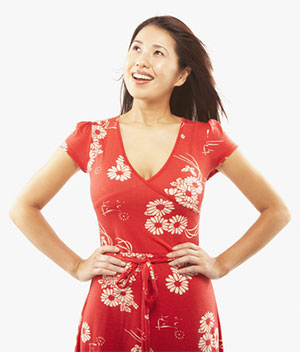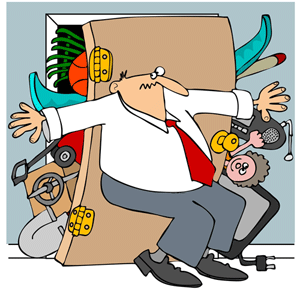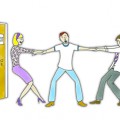
Strong confident posture actually boosts your feelings of confidence and reduces stress
When you are sad or angry or happy, you tend to look sad or angry or happy.
Ok, that’s not rocket science.
But what I think you will find intriguing is that psychologist Paul Eckmann found that, no matter what culture you happen to born into, even some utterly remote culture that has never had contact with other cultures, if you’re sad, you tend to look down, make your body smaller by folding your arms perhaps, or you cry.
And when you’re happy you tend to smile and look upwards. When you feel brave and confident, you look brave and confident and when you are scared, you look scared.
In other words, the facial expressions and body postures, or what you might call ‘body language’ of emotions are universal and hard wired, rather than culturally driven or learned.
It’s not as if in Russia, say, they scowl when they are happy or smile when they are sad. The expressions and body postures associated with fear or happiness or anger… or whatever emotion… are universal.
The universal language of emotion
So when you’re confident, you hold open body postures and you look up.
Imagine someone sitting at a desk, their feet resting on the desk, sitting back with their hands clasped behind their head – that’s a confident look. Of course, you can look confident standing up or sitting down.
Now imagine someone looking down at the floor, arms crossed as if they are protecting themselves.
In one posture, you are nice and open and taking up space, and in the other, you are trying to make yourself smaller, literally as if you don’t want to be, or feel as if you shouldn’t be, there at all.
So when we feel an emotion it tends to make us look a certain way. But that’s not quite the whole story.
The Cocktail Party
When we ran our advanced hypnosis workshop live (it’s now online) we would finish with a fun exercise called ‘The Cocktail Party’.
People were paired off and each person was given a card with an emotion written on it. So, for example, person A might have ‘sad’ written on his card, while person B might have ‘confident’ written on her card.
Then they were told to spend a couple of minutes talking about the weather or where they’d like to go or had been on holiday. But they had to talk with the facial expressions and body posture of the emotion on their card.
So person A with the ‘sad’ card would have to chat while looking sad and depressed, head down, miserable voice and so on.
In the meantime person B with the ‘confident’ card, would discuss weather or holidays while acting as confident as possible, open posture, head up, smiling and so on.
After a couple of minutes of talking ‘in character’ or, should I say, in the character of the emotion card they had been given, they were asked to swap cards but keep the same facial expressions and body posture.
So the person who had been looking sad had to continue looking sad, but try to communicate as if they felt really confident, while the other person had to continue looking really confident but talk as if they were really down…
As you can imagine, with a roomful of people, this got pretty hysterical.
The effects of ‘acting’
We noticed two important things from this exercise.
Firstly, our students would start to really feel the emotion they were acting. So ‘sad’ people with sad expressions and body postures would start to genuinely feel negative, while people with the ‘confident’ or ‘happy’ or ‘angry’ cards would also start to feel that way.
Secondly, it was nigh on impossible to swap cards and maintain a confident body posture and facial expression while acting sad or frightened.
So our physicality and the way we express that is caused by the emotions we feel.
But it also works the other way.
The two-way street
How we stand, and with what facial expression, can also make us feel a certain way and this has been borne out by scientific research.
It’s even been found that forcing yourself to look a certain way for just a couple of minutes can change the balance of certain hormones.
So this is powerful stuff.
If you watch people interacting, some will look powerful – even if they are physically small, they will still look confident and self possessed.
Psychological researchers have recently got interested in whether you can get people to have specific feelings and thoughts by getting them to behave in a certain way.
The answer is – you can.
For example, when people are artificially made to smile – they are told to hold a pencil long-ways between their teeth while doing a task – they report feeling more satisfaction with their task, and more upbeat generally.
This tells us that just working the ‘smile muscles’ of the face can make people feel better.
It’s also been found that teenagers who talk about what they want to do in the future feel much more confident that they will be able to achieve their goals when they talk about them sitting in an upright position, looking up.
So what’s going on here?
It’s the hormones
Men and women who are confident tend to have higher levels of the hormone testosterone and lower levels of the stress or fear hormone cortisol.
But guess what? How you sit or stand can increase your testosterone levels and simultaneously lower your cortisol.
Can you control your hormones?
Social psychologist Amy Cuddy at The Harvard Business School showed that adopting a so-called ‘power pose’ – the classic confidence posture, open body, arms outstretched, head up – for two minutes can raise testosterone levels by a fantastic 20%!
Testosterone is associated with confidence and social dominance, of course, but such a power pose also lowers stress (as measured by cortisol levels in saliva). So, as you feel more confident you also, of course, feel more relaxed.
Cuddy even recommends adopting a power pose for two minutes in the bathroom before a job interview (and, in fact, even this was tested in the lab!).(1)
Cuddy got test subjects to undergo a five-minute interview with unfriendly, impassive interviewers.
Without being told why, some of the participants were told to adopt power poses for two minutes before the interview, while others were told to adopt low power postures for two minutes. The interviews were videoed.
People who viewed the videos without knowing anything about the study all stated they would hire the interviewees who had adopted the confidence-inducing power poses just before being interviewed.
They described these people as ‘confident, passionate, enthusiastic, captivating, interesting, comfortable and authentic.’ A large pay off for a two minute power pose!
What I learned from this
Since learning about this research, I am careful not to hunch over my computer too much, or look down for long periods of time while sending texts. What we do with our bodies during the day has direct and immediate effects on our psychology – and on our life as a whole.
So how can you apply this in your everyday life? Other than avoiding ‘low power’ body postures?
How to use this information
A good time to use a power pose is when you face a ‘social threat situation’, perhaps during a time when you feel you might be judged.
This might be:
- in a job interview
- on a date
- when public speaking
- when you have to have a difficult conversation with someone
- meeting new people.
Before you go into the situation, perhaps in the bathroom where no one can see you, stand or sit:
- upright
- head up
- arms wide, maybe on your hips posing like the most confident person in the world.
Remember, it will instantly:
- lower your stress hormone levels and
- raise your testosterone levels.
Then, when you are actually in the situation, without being too exaggerated about it:
- keep your head up and
- keep your body posture open.
And see how much more confident and relaxed it makes you feel.
The human body and mind are more interconnected than we know (in our modern society anyway).
Notes:
- Amy Cuddy’s TED talk about her research










